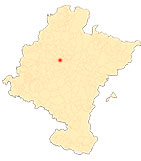18th Century Pamplona Palaces
The ornamentation of the building
Few of the main houses preserved have preserved their original structure and interior decoration, which often exceeded the wealth of the building itself. Thanks to the wills and inventories of goods, we know that they were adorned with rich furnishings, screens, cornucopias, clocks, tapestries, etc. Also hanging on the walls were canvases signed by the most famous painters of the Court and even Italian, Flemish and New Spain, both of civil themes, highlighting the portraits of the illustrious characters of the family and the cycles of classical mythology, and religious themes, with special attention to the patron saints of the family, those of the Kingdom, or those of their original places of birth. There was also no lack of exotic objects from the Indies, especially tibores, ivories and coral objects. In addition, they had private oratories, full of goldsmith objects and relics, including small altarpieces, which turned them into small "chambers of wonders". On the exterior, in addition to the heraldic coats of arms, the forged ironwork and grilles, applied to the windows of the lower floor and the balconies, where the nobles showed themselves to the common people, were outstanding. accredited specialization doors and windows deserve special mention, often with highly decorative solutions and of great complexity, without reducing their resistance.
ANDUEZA UNANUA, Pilar, La arquitectura señorial de Pamplona en el siglo XVIII. Familias, urbanismo y ciudad, Pamplona, Government of Navarre, 2004.












